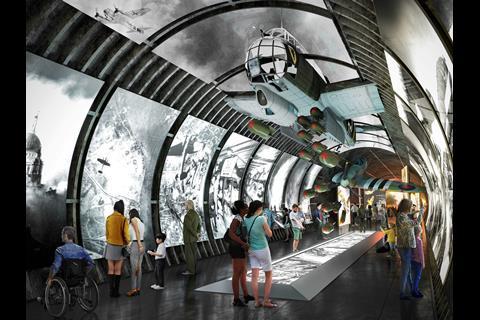Australian banker Angus Murray given three years to start construction work on £220m visitor attraction
Wilkinson Eyre’s £220m plans to turn a sprawling network of secret Second World War tunnels beneath central London into a visitor attraction have been given the final go ahead.
Camden council unanimously approved the Kingsway Exchange Tunnels scheme yesterday evening, a month after the City of London voted to green light the plans.
The deep-level subterranean network, located 42m beneath Holborn, runs for 8,000 sq m across the boundary between the two boroughs and needed approval from both councils to go ahead.
London Tunnels Ltd, a private company run by Australian banker Angus Murray, now has three years to start construction work on the tourist attraction, which is expected to draw in up to two million visitors a year.
Originally built as a bomb shelter for Londoners in the 1940s, the tunnel network later served as the headquarters of a covert Special Operations Executive branch for MI6 and was the inspiration for the Q Branch in Ian Fleming’s James Bond novels.
Accessed through two discreet entrances on Fulwood Place and Furnival Street, the tunnels were once so clandestine that all staff who worked there were required to sign the Official Secrets Act.
After an expansion during the Cold War they became a telephone exchange which hosted a hotline between the United States and the USSR. During the Cuban Missile Crisis in 1962, staff were locked in for two weeks with water supplied by its own self-sufficient wells.
Ownership passed to British Telecom in the 1980s, which built the world’s deepest licenced bar for government staff complete with snooker tables and a tropical fish tank.
This bar, located at the western end of the network, will be restored as part of Wilkinson Eyre’s plans and stay open after hours from 10pm to 1am with space for 160 people.
With its small capacity, it will be available by booking only and accessed through the Fulwell Place entrance, currently a nondescript metal door on an alleyway leading off the main road.

The plans will also see the demolition and reconstruction of the City of London entrance at 38-39 Furnival Street and the redevelopment of 40-41 Furnival Street for the attraction’s main entrance.
Above the ground floor of the new building at 40-41 Furnival Street would be two floors of retail space and two floors of office space. Both structures would have three basement levels.
Wilkinson Eyre said the tunnels themselves will require full strip-out and repair, including the removal or encapsulation of asbestos.
The attraction will include a suite of temporary exhibition spaces and a permanent heritage trail allowing visitors to engage with key historical moments linked to the tunnels’ use from the 1940s through to the cold war.
The tunnels could also be used for exclusive events such as fashion shows and corporate dinners, according to Wilkinson Eyre.
The project team also includes Gardiner & Theobald as project manager, Aecom as QS, WSP as project engineer and Future City as cultural consultant.






































No comments yet